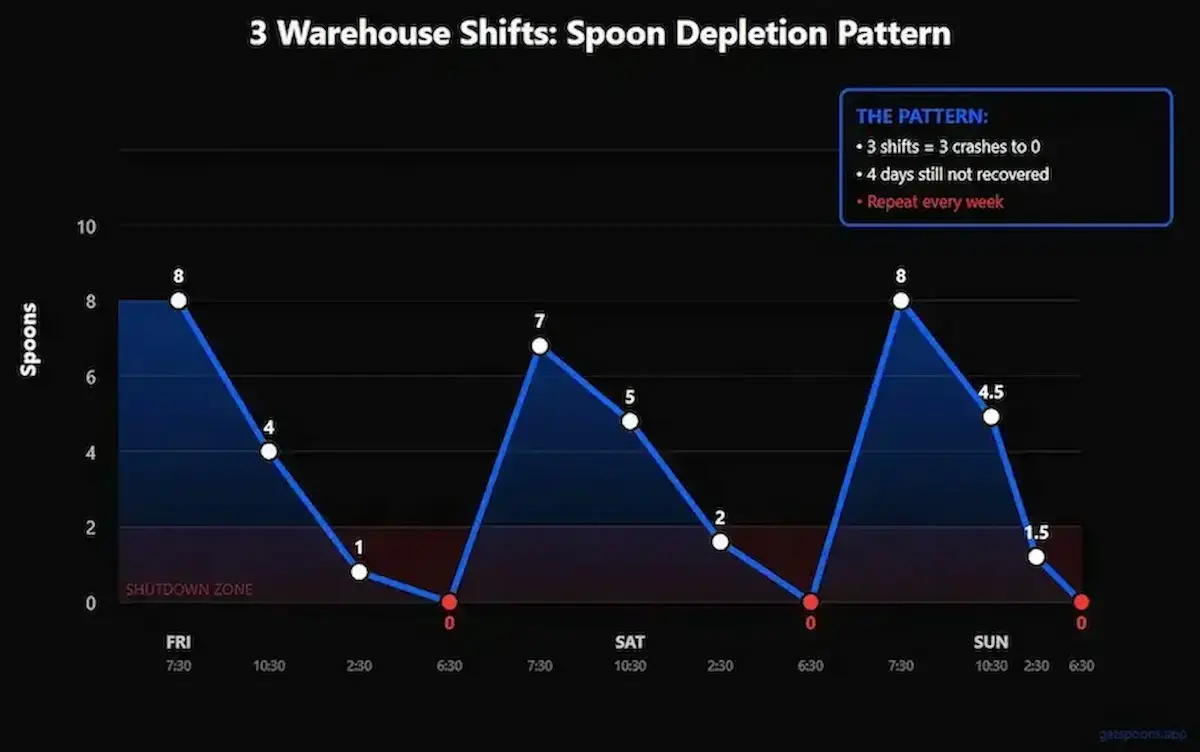Hour 6 of my 10-hour warehouse shift: 3 spoons left. Two options:
1) Power through the next 4 hours and hit 0 spoons (shutdown by end of shift)
2) Take strategic 10-minute micro-rest (finish shift at 2 spoons, functional tomorrow)
Neurotypical advice says "just push through" or "take a coffee break."
Neither of them work for us. Here are the micro-rest strategies that actually restore energy instead of depleting it further— tested during warehouse shifts where failure means shutdown or even burnout.
Neurotypical break advice assumes:
Autistic micro-rest needs:
What it is: Lock yourself in the bathroom stall, close your eyes, and take deep breaths.
Why this works: Sensory reduction, social isolation, and a predictable space to recovery
When to use: When you're at 4-5 spoons and/or starting to feel overwhelmed and drained.
Spoon restoration: +0.5 to +1 spoon
My warehouse example:
What it is: Reduce auditory input during work tasks (if job allows).
Why it works: Eliminates constant sensory drain from background noise
When to use: Entire shift if possible, or during high-noise periods
Spoon restoration: Prevents -1 to -2 spoon drain over shift.
My warehouse example:
What it is: Simple, mindless physical activity (stimming, organizing, or stretching)
Why it works: Cognitive rest while body moves, predictable pattern for us
When to use: When cognitive load is high, physical energy remains.
Spoon restoration: +0.5 spoons (mainly prevents further drain)
My warehouse example:
What it is: Sit or lie down, close eyes, no input
Why it works: Complete sensory reduction, nervous system rest
When to use: When at 3-4 spoons, need immediate restoration
Spoon restoration: +1 to +1.5 spoons (most effective strategy)
My warehouse example:
What it is: Consume content about special interest (read, watch, or listen)
Why it works: Active restoration through engagement with things that passionate or excite you
When to use: When energy low but not critical (3-5 spoons)
Spoon restoration: +0.5 to +1 spoon
My warehouse example:
What is it: Box breathing (4-4-4-4) + Physical grounding techniques
Why it works: Vagus nerve stimulation, parasympathetic activation
When to use: Early signs of overload (5-6 spoons dropping to 4)
Spoon restoration: +0.5 spoons (Mainly prevents crash)
My warehouse example:
What it is: familiar, repetitive task you've done 100+ times
Why it works: Zero cognitive load, accomplishment feeling
When to use: Need mental break but can't fully disengage from work
Spoon restoration: +0.5 spoons
My warehouse example:
Why people try it: I'm taking a break, need to relax"
Why it fails: Visual stimulation + decision fatigue + social media = drain
Net effect: -0.5 to -1 spoons (makes things worse)
Why people try it: "Energy boost"
Why it fails: Masks depletion temporarily, crash harder 2 hours later
Net effect: Borrow 1 spoon from future self (worse overall)
Why people try it: Neurotypical advice ("chat with coworkers!")
Why it fails: Often leads to masking and social processing = active energy drain
Net effect: -0.5 to -1 spoon (opposite of restoration)
Why people try it: "I don't have time for longer"
Why it fails: Autistic nervous system need 10+ min to actually reset (Due to the massive sensory,cognitive, and/or social load we've been dealing with)
Net effect: 0 spoons (no restoration, just interruption.)
The strategies above do work for me, but you might respond differently (Some scenarios may drain you more so than others)
The only way to know this is by:
Example tracking:

Manual tracking works but adds cognitive load (Ironic, since you're already depleted). That's why I'm building Spoons to make this simpler: to log pre/post energy with one slider, automatic pattern detection, and to see if micro-reset actually work for you or not.
Once you know what works for you, try making a protocol:
Example: My warehouse shift protocol
Your protocol variables:
Test, track, refine. Your protocol should be:
Micro-rest isn't optional for autistic adults in the workplace—it's the difference between being functional and shutting down. Neurotypical break advice doesn't just fail to help; it actively makes things worse and more complicated for us then it ever should be.
The strategies that work:
Micro-rest isn't optional—it's survival strategy. Track what works. Build your protocol. Ignore neurotypical break advice.
Your nervous system will thank you.
If you want to track which micro-rests work without added cognitive load, join the Spoons waitlist.